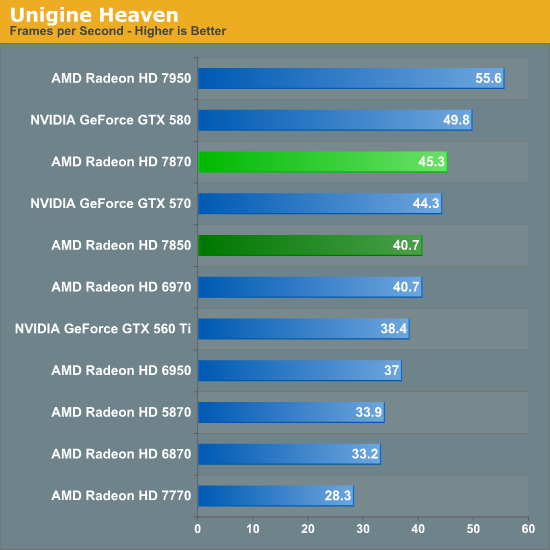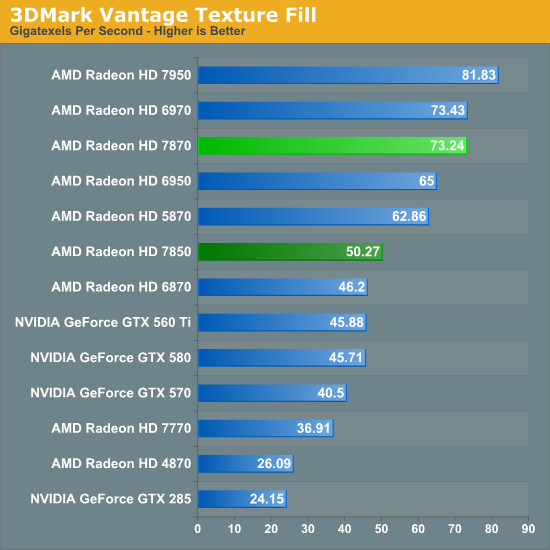AMD Radeon HD 7870 GHz Edition & Radeon HD 7850 Review: Rounding Out Southern Islands
by Ryan Smith on March 5, 2012 12:01 AM ESTTheoretical Performance
Before moving on from compute performance, we wanted to quickly take a look at theoretical performance. This will be particularly helpful for highlighting the importance of core clockspeeds in AMD's GCN architecture.

We’ll start with a quick look at tessellation performance with the DX11 Detail Tessellation sample program. Because the 7900 series and the 7800 series share a common dual geometry engine frontend, geometry performance is almost entirely dictated by the core clock. As a result the 7870 and its 1GHz core clock just edges out the 7950 and its 800MHz core clock when it comes to tessellation performance. The rest of the difference comes down to shaders, where the 7950 has more shader resources to throw at the hull and domain shading parts of the tessellation process.

Of course that tessellation performance lead doesn’t always translate into great performance in tessellation heavy benchmarks. Unigine Heaven, in spite of its heavy use of tessellation still has the 7950 well ahead.


Finally, a quick look at 3DMark Vantage theoretical performance largely confirms what we’ve already seen. Pixel fill is heavily bandwidth limited, leading to the 7950 taking a large lead and even the 6970 edging out the 7800 series, though you’d never know it from the gaming benchmarks. Otherwise when it comes to texture fillrate, the 6970 and 7870 are in a dead heat.










173 Comments
View All Comments
ET - Monday, March 5, 2012 - link
I agree it's kind of disappointing. Even a 5750 was a good improvement over a 3870, and here there's nothing approaching this kind of performance benefit over the 5870 from these. Though I think part of it is that the 5870 still holds up well in many games, as these benchmarks show.Kjella - Monday, March 5, 2012 - link
I don't think it's that terrible... the 7870 fits pretty much the exact same power envelope as the 5850 and is starting to be a pretty solid performance upgrade. Yes it's a $350 card but inflation adjusted the $279 (pre-hike) 5850 is nearing $300 in 2012 dollars. A good deal and a good cooler (the reference cooler on the 5850 works, but is hardly quiet) and they may get a sale. Just waiting for Ivy Bridge, if nVidia hasn't shown a stunning Kepler by then I think the 7870 is it.Death666Angel - Tuesday, March 6, 2012 - link
Average increase of 40% in performance and you are comparing a high-end graphics card to a mid-range graphics card.DominionSeraph - Monday, March 5, 2012 - link
So, AMD discontinued the $250 6950 and $350 6970 to give us... a $250 6950 and $350 6970.Not exactly impressed.
Looks like it will be up to Nvidia to save us, just as they saved us from the price-gouged 5000 series with aggressive release price of the GTX 460 with price drops on the GTX 470. (That one action set the pricing scheme throughout the 6000/500 series)
CloudFire - Monday, March 5, 2012 - link
I'm not upgrading this cycle but I do wish to see Kepler out sooner to drive down prices. This is business and AMD has a few months of no competition so they are going to do all they can to reap massive profits.Nvidia isn't going to save you, they would do the same thing if they were in AMD's position. Remember nearly 5 years back with the 8800GTX going for 500+ for over a year? Yea......
DominionSeraph - Tuesday, March 6, 2012 - link
A halo product with no competition is beside the point. We're talking about the 7800 series which sits right in a range where there are competing products, and AMD is pricing it to suck you dry.The fact is that the 7000 series is not undercutting the 500 series the way Nvidia undercut the 5000 series. A $250 7850 vs a $270 + free Batman Arkham City GTX 560 Ti 448 Cores is about equal price/performance (maybe a tad in the favor of Nvidia). Contrast this to the GTX 460 being released at $200 when the 5770 was $180. The GTX 460 blew the doors off the 5770 and instantly said the appropriate price for that card is ~$130. A few months later we were seeing $110 5770's and $150 GTX 460's, and that's where we've been at ever since.
AMD refuses to aggressively compete with Nvidia. They simply slot their products into Nvidia's pricing structure. So prices only change when Nvidia drops theirs and AMD is forced to follow. This means that we, the consumers, are dependent on Nvidia to save us, because AMD sure as hell won't.
Exodite - Tuesday, March 6, 2012 - link
Not really a valid point of comparison though.Looking through several reviews of the 7800-series the 7850 lies closer to a 570 than a 560 Ti most of the time, while offering more and better in every possible category.
Sure, the 7850 isn't on the market yet but assuming the ~250 USD pricing holds true I couldn't possibly recommend a 560 Ti, or even 448 core version, over the 7850 with a straight face.
It could still be cheaper, sure, but it's nowhere near the pricing disaster the 7900 and 7700 series are.
To my mind the 7800 series were the ones to wait for.
Granted, with a 6950 myself I won't be upgrading until the 8k-series at the earliest. Unless Kepler turns out truly amazing, and brings triple display functionality on a single card.
tipoo - Monday, March 5, 2012 - link
If I recall Nvidia hasn't really under-priced AMD in recent memory, they've always tried x more performance sold for >x price.ET - Monday, March 5, 2012 - link
"AMD discontinued the $250 6950 and $350 6970 to give us... a $250 6950 and $350 6970."When you put it this way, it's quite a likeable upgrade actually. Slight boost in performance, lower power and better thermals, upgraded features, all for the same price. What's not to like?
chizow - Monday, March 5, 2012 - link
What's not to like is it took them 16 months to put out a greener refresh sidegrade.